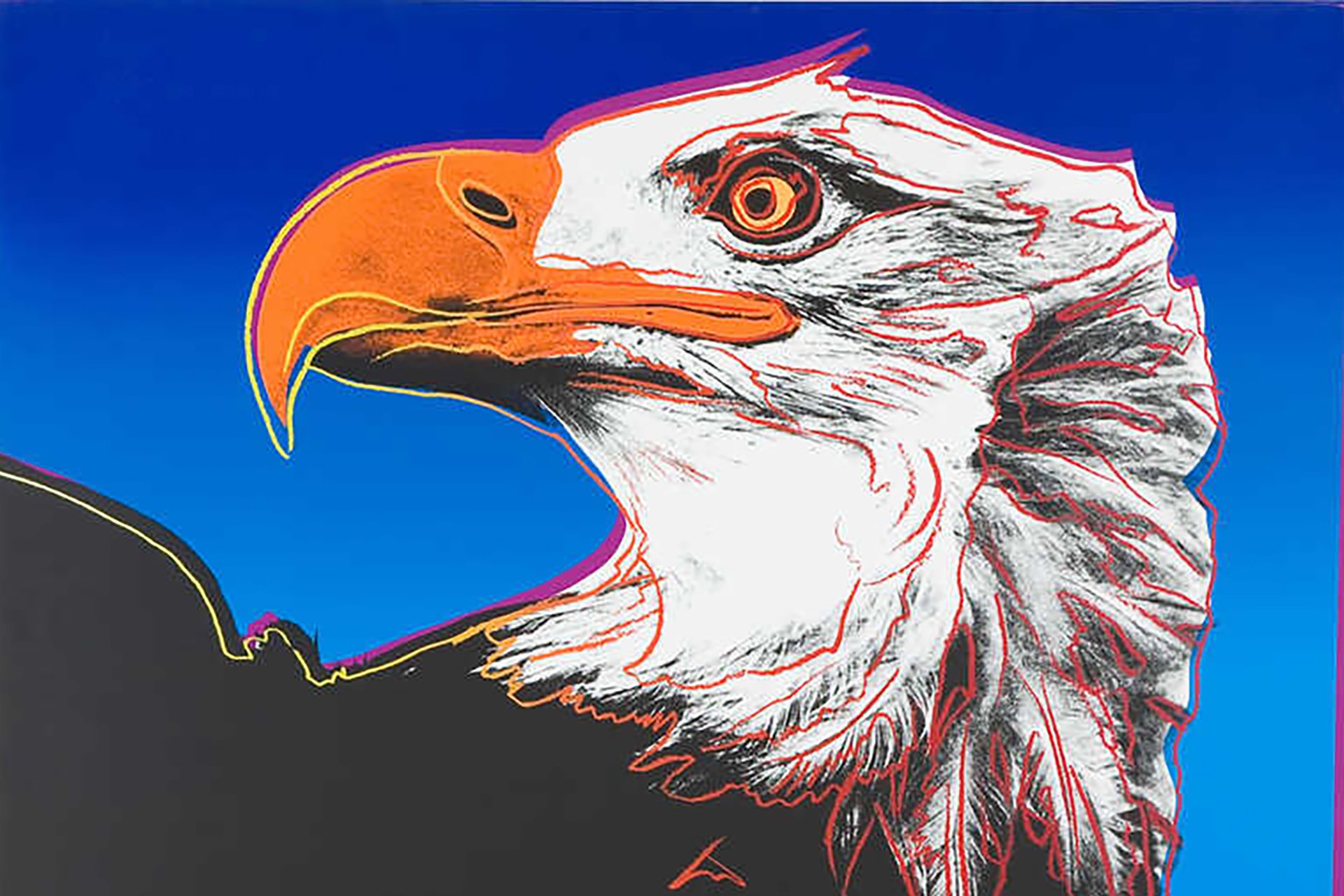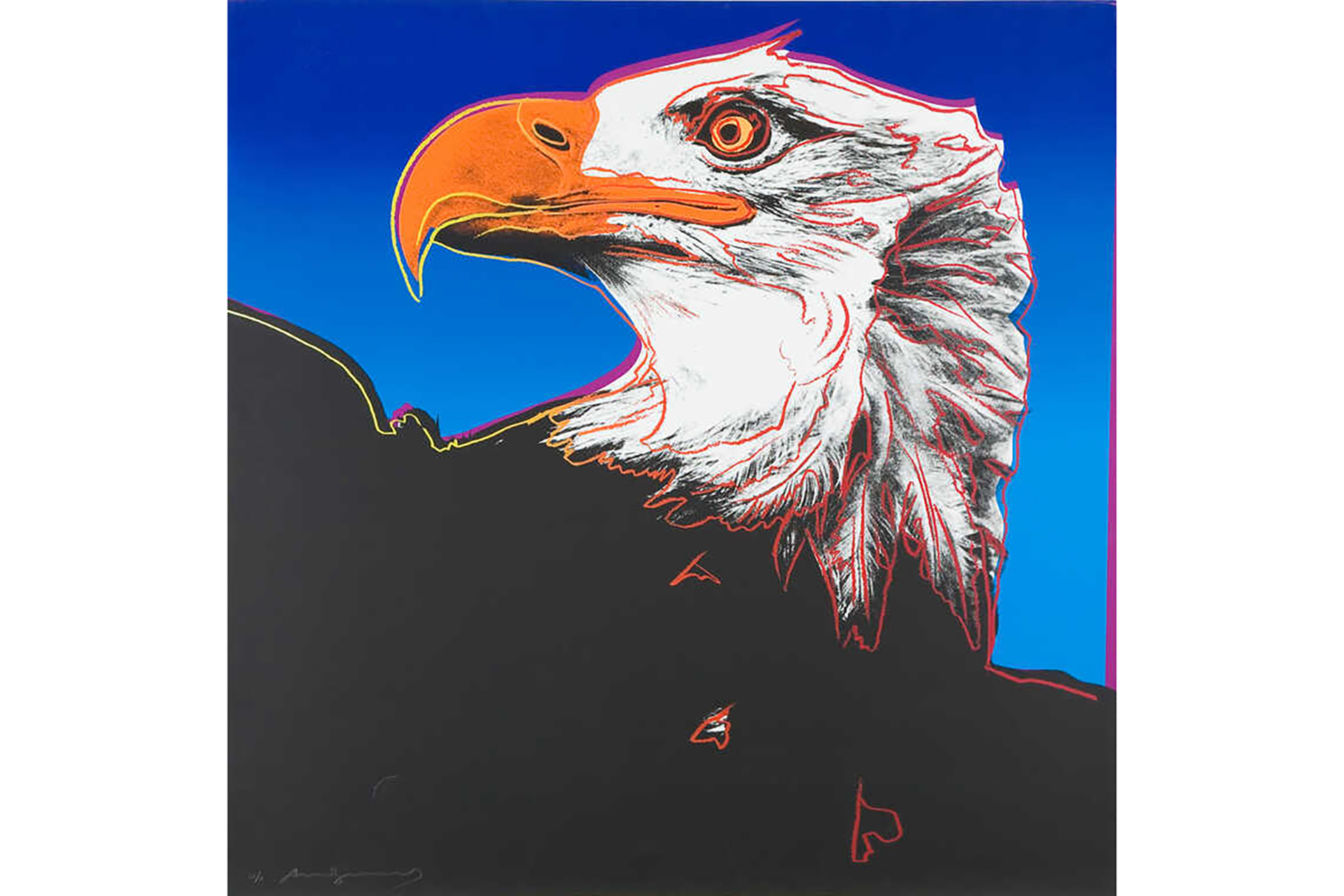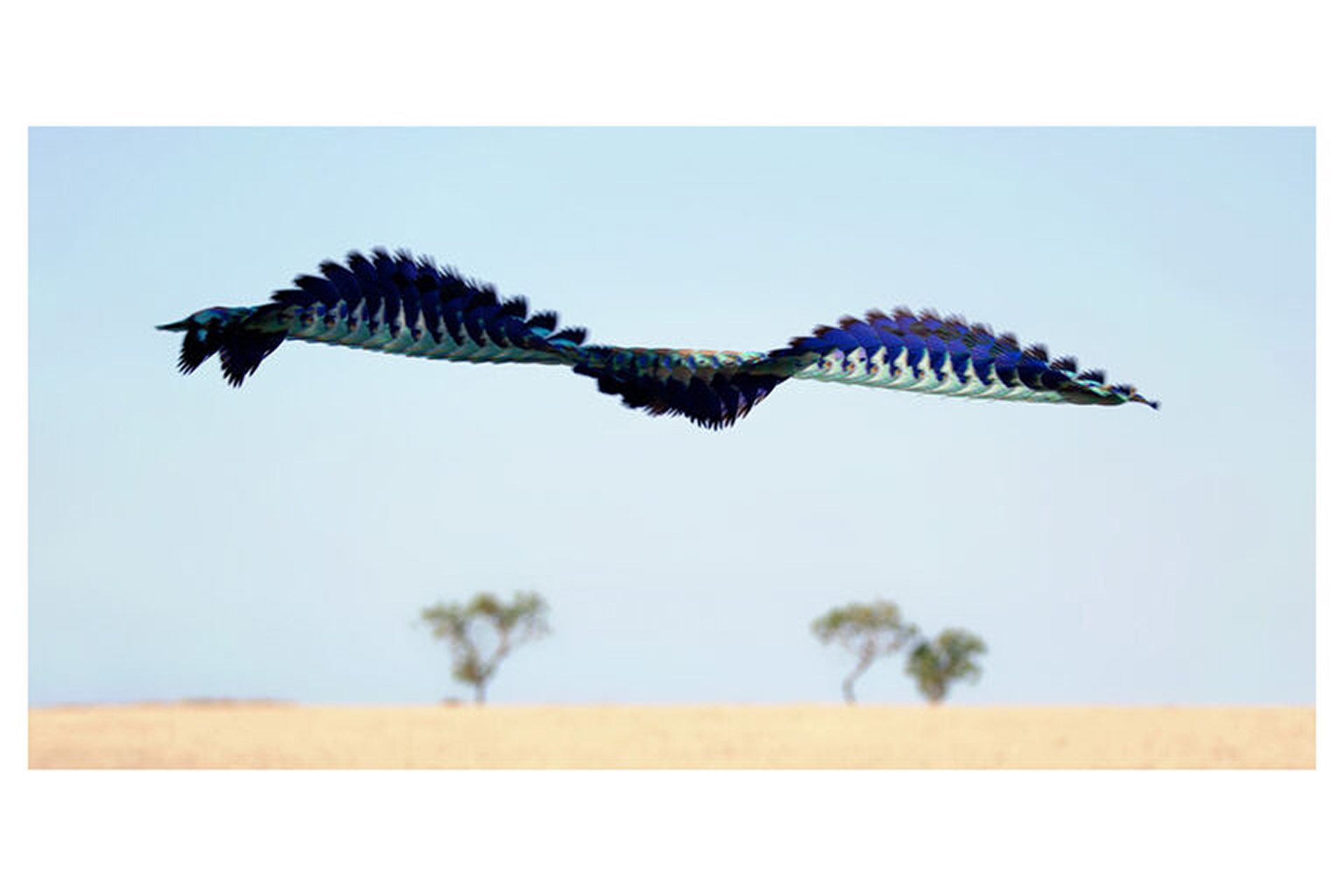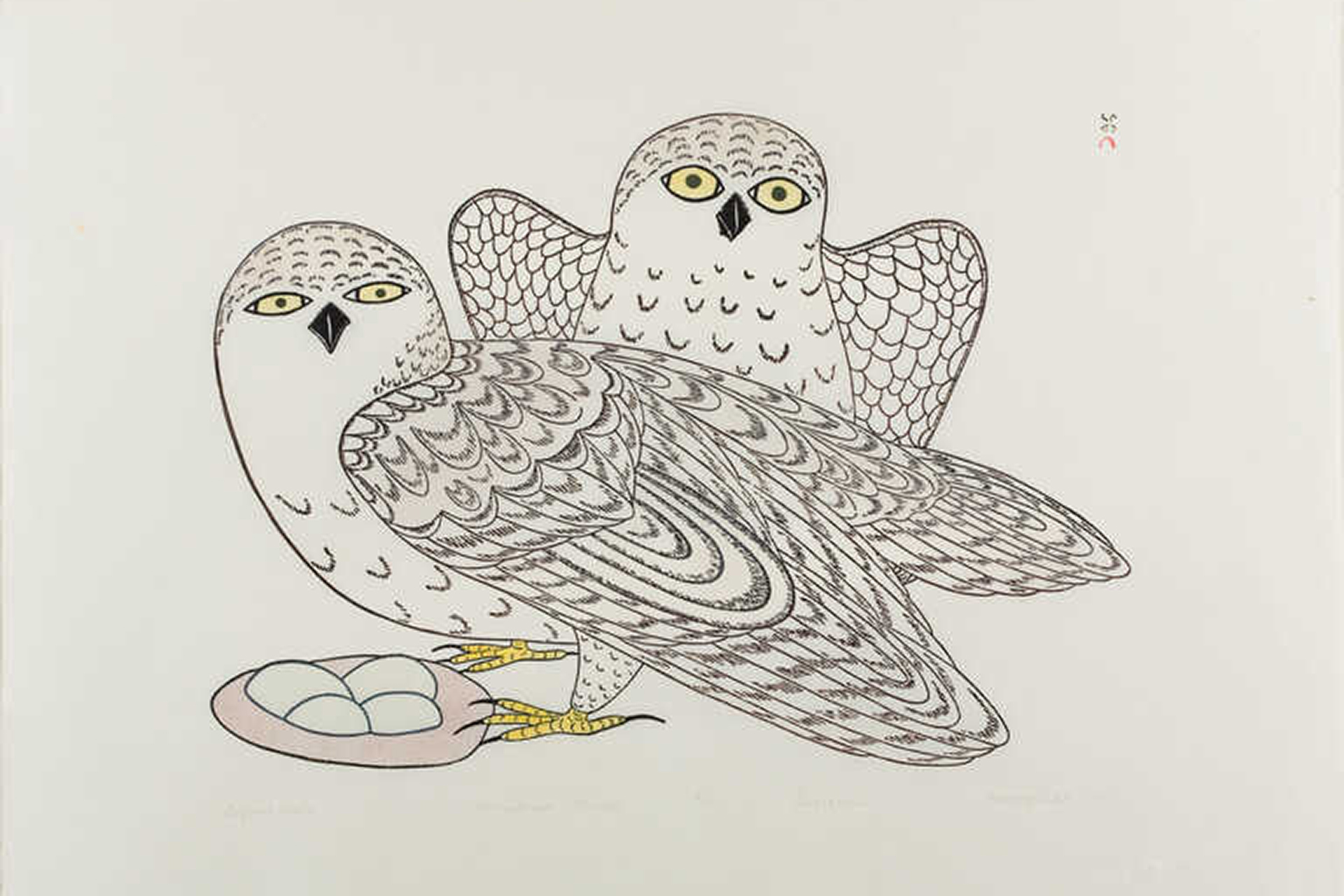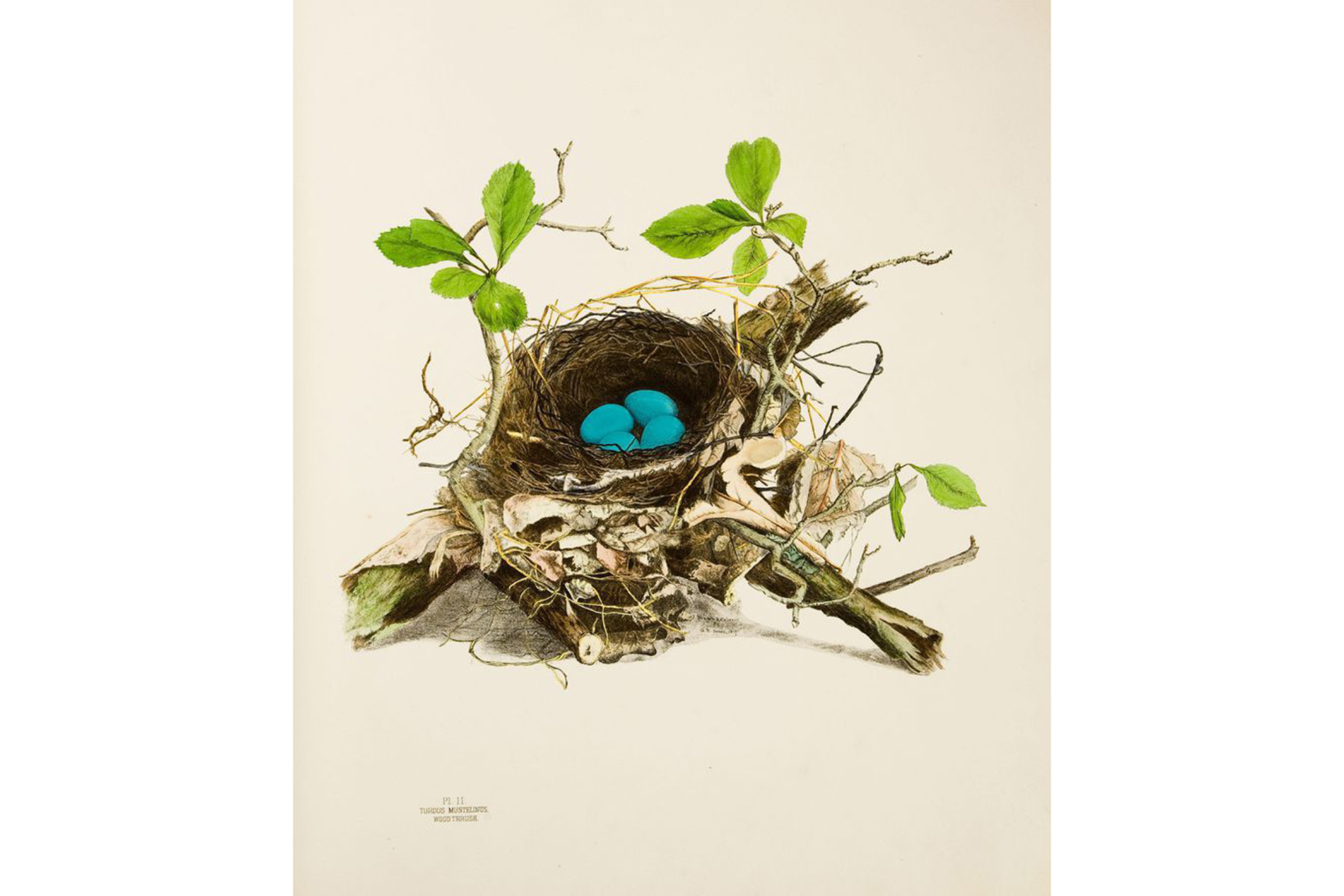Museum of American Bird Art News
Art and Nature: A Lasting Relationship Reflected through the Collection at the Museum of American Bird Art
August 21, 2025
[This article is adapted from a lecture presented by Dr. Jennifer S. Tafe at the Concord Free Public Library on April 29, 2025, on MABA’s temporary loan to the library of Andy Warhol’s Bald Eagle in celebration of the 250th anniversary of the American Revolution. Reprinted with permission from Bird Observer August 2025, Volume 53, Number 4.] www.birdobserver.org
Bald Eagle by Andy Warhol, silkscreen, 1983. Mass Audubon Collection; gift of the Artist, 1983. © Warhol Foundation.
Nature has been a wellspring of artistic creativity and cultural expression for centuries. This article explores the enduring relationship between art and nature, and the ways in which this intersection has been manifested and celebrated throughout art history and within the collection of Mass Audubon’s Museum of American Bird Art (MABA).
Since the earliest known artworks were created, artists have looked to their craft to help interpret the human relationship to the natural world. Birds, other wildlife, and the habitats in which they live have served as subjects for art, literature, mythology, legend, and symbolism across cultures, time, and geography. The manner in which nature subjects have been used in art has changed over time, especially as our scientific understanding has evolved, and as the fragility of nature and our planet has become more apparent.
Ancient Egyptian artists revered the land and its wildlife for the abundance and vitality it provided in life as well as in the afterlife; they decorated tombs with intricate scenes of hunting, fishing, and the worship of animal-inspired gods. The Romans sought to bring the natural world indoors, seeing the splendor of native plants and wildlife species as coveted luxuries to decorate the frescoed walls of their lavish interiors. In the Baroque period, illustrating fables in vivid colors, artists used birds as moral symbols by depicting them engaged in human-like behavior. In the eighteenth and early nineteenth centuries, the artist-naturalist emerged, producing illustrations that emphasized anatomical accuracy, detailed plumage, and the inextricable relationship between birds and habitat.
This long tradition of artists interpreting the natural world has resulted in stunning work such as Andy Warhol’s Bald Eagle painting. Warhol, like centuries of artists who came before him, was inspired by wildlife to reflect on the changing human relationship to nature. Best known for his celebrity portraits and Pop Art style, Warhol was commissioned in 1983 by a New York gallery to create a special series of paintings. He called it his Endangered Species series—ten portraits highlighting some of the most vulnerable animals in the world, rendered in Warhol’s signature and iconic style. He referred to these portraits as “animals in make-up.” Moved by growing concerns about environmental threats, Warhol donated 100 of these paintings to nature and conservation organizations around the United States, and Mass Audubon was fortunate to receive two: Bald Eagle and Pine Barrens Tree Frog.
Ornithographies #89 by Xavi Bou, photograph, not dated. Mass Audubon Collection; gift of Alfred Chandler, 2021.
Though rarely considered a wildlife artist, Warhol demonstrates through his endangered species paintings that even the most unexpected people can be deeply influenced by nature. The artist’s bold and unconventional interpretation of the endangered species also illustrates art’s unique ability to convey complex issues to a broad audience.
Long before Andy Warhol donated these two paintings to the organization, Mass Audubon recognized the power of art to communicate scientific and environmental information to a wide and diverse audience. Harriet Hemenway and Minna B. Hall—two pioneering women in the conservation movement—founded Mass Audubon in 1896 as the result of a campaign against the feather trade that was decimating bird populations. Their efforts persuaded women across Massachusetts to abandon feathered hats, initiating a grassroots movement rooted in advocacy and education. From its inception, Mass Audubon employed art as a tool to educate the public about nature and conservation.
The Museum of American Bird Art was established a century later when a small gallery opened to the public in Canton, Massachusetts, in 1999. Since then, the collection has grown, thanks to many generous donors, collectors, artists, and especially to Mass Audubon’s leaders who have championed art. The collection now includes more than 3,000 works spanning more than 400 years of art history. It features a wide range of media—watercolors, etchings, drawings, oil and acrylic paintings, sculpture, photography, and archival materials—as well as an extensive art library.
Defiant Owls by Kananginak Pootoogook, 1982. Mass Audubon Collection; gift of Judy Samelson and William Schawbel, 1994.
The collection includes such diverse works as Larry Barth’s sculpture of a Yellow-shafted Flicker, a special Mass Audubon commission; Inuit artist Kananginak Pootoogook’s stone-cut print called Defiant Owls; Charley Harper’s iconic painting, Mystery of the Missing Migrants; and American Impressionist Frank Benson’s luminous oil painting, The Duck Marsh. All the works in MABA’s collection represent the varied and unique ways artists interpret the natural world, show us new ways of seeing, encourage us to experience and revere the world around us, and help us connect more deeply to our environment. The Museum of American Bird Art exemplifies the power of the relationship between art and environment, which can create a more empathetic world that inspires us to environmental awareness and advocacy.
Louis Agassiz Fuertes was one of the earliest artists to be commissioned by Mass Audubon. Fuertes was recognized early in his career for his talent for painting birds, which began at Cornell University. He was a teacher and influential mentor, and he traveled all over the world on various scientific expeditions where he painted directly from life. MABA owns many works by Fuertes, including a regal osprey framed naturally by a curling tree snag, and an original watercolor commissioned by Mass Audubon in 1916. The organization asked Fuertes to paint a bird chart, and his lively interpretation of this assignment resulted in hundreds of reproductions which were made and distributed to classrooms all over the country to educate students about migratory birds.
An underrecognized figure in the conversation around art and nature is Genevieve Jones, a young woman who in 1878 set out to produce the first book in America to document birds’ nests and eggs. Only 100 copies of this extraordinary book were produced; the museum holds a rare copy that features an elaborate, hand-painted frontispiece. It is a monumental book, and the artwork is extremely detailed, done with remarkable skill and sensitivity that reflects close observation of the nests and eggs she collected. Tragically, Genevieve Jones died before completing the project, and the remaining illustrations were completed by her mother and childhood friend. Illustrations of the Nests and Eggs of Birds of Ohio (1886) is a beautiful book that stands as a powerful testament not only to Jones’s pioneering work in scientific illustration, but also to the devotion of her family and friends who carried her vision forward.
Plate II. Turdus mustelinus by Genevieve Jones, lithograph and watercolor, in Illustrations of the nests and birds of Ohio, 1886. Mass Audubon Collection; gift of Eugene Doggett, 2012.
MABA’s collection includes several works by celebrated artist Francis Jaques, a self-taught wildlife artist and taxidermist who worked for the James Ford Bell Museum of Natural History in Minneapolis and the American Museum of Natural History in New York in the early twentieth century. He illustrated many natural history books, but he was best known for the dozens of dioramas he painted as backgrounds of exhibits in natural history museums. MABA is fortunate to have several of Jaques’s paintings in the collection, including portraits of Great Black-backed Gulls and Green-winged Teals, and a large-scale marsh scene of Redheads and Ring-necked Ducks. Today, Jaques is remembered as an outstanding wildlife painter and naturalist whose sympathetic depictions of wildlife contributed to the education of visitors to natural history museums.
One of the museum’s most beloved and robust collections is that of Robert Verity Clem, a gouache painter who captured birds and landscapes of New England with exceptional precision, intensity, and care. Conservation was always at the heart of Clem’s work because he was deeply committed to the well-being of birds and their habitats. His illustrations for The Shorebirds of North America (Matthiessen 1967) remain a landmark in bird art. In 2024, MABA was honored to receive Clem’s painting of a Snowy Owl, originally painted for Gardner Stout, editor of that seminal publication.
Field guide illustration is another area in which artists have played an important role in supporting scientific understanding of birds. MABA has a substantial collection of original watercolors painted for field guide plates, including works by Roger Tory Peterson, Arthur B. Singer, David Sibley, and Cindy House. These artists have contributed to the science of ornithology in a distinct way, demonstrating how art can bridge science and accessibility, offering critical tools for learning and identification.
Barry Van Dusen, a contemporary field artist and close collaborator with Mass Audubon, exemplifies the expressive and observational depth that field art can convey. From 2015 to 2017, Van Dusen served as MABA’s artist in residence, traveling to sanctuaries across Massachusetts and producing more than 200 watercolors, which he published in Finding Sanctuary (2020); he generously donated his sketchbooks to the museum. Each sketch is a complete and evocative painting that captures the artist’s deep engagement with place and species.
Photographer Sharon Beals offers a more confrontational yet equally moving approach. Her images of nests belonging to extinct and endangered species are beautiful but sobering, highlighting the fragility of wildlife in the face of human impact. She photographed natural history collections, and her images simultaneously reveal loss and resilience, reminding us of what has been eradicated and what might still be saved. MABA is fortunate to have two of Beals’s large-scale photographs.
Art can play a powerful role in shaping environmental consciousness. The work of Spanish photographer Xavi Bou exemplifies this capacity. Bou’s dramatic image of a European Roller in flight—composed from hundreds of digitally layered photographs—visualizes bird movement in ways the human eye cannot perceive. His work speaks to the beauty and intricacy of avian life while underscoring the need for habitat preservation.
Visual art holds a singular place in the conversation around nature. It distills complexity, communicates urgency, and lodges in our memory. Art has long challenged indifference and inspired action. At its best, it prompts us to slow down, look more closely, and think more deeply. At the intersection of art and nature lies not only beauty, but also a wellspring of creativity and a source of hope in addressing the environmental challenges of our time.
Looking ahead, the Museum of American Bird Art is charting a bold new course. We are reimagining our future by expanding our audiences, diversifying the collection, and launching innovative, interdisciplinary programs. A key part of this vision includes establishing a new home for the museum to better share our collection and mission with the public.
References
- Jones, Howard. 1886. Illustrations of the nests and birds of Ohio. Circleville, Ohio. https://www.biodiversitylibrary.org/page/53201346. Accessed May 17, 2025.
- Matthiessen, Peter. 1967. The Shorebirds of North America. New York, New York: Viking Press.
- Van Dusen, Barry. 2020. Finding Sanctuary. Lincoln, Massachusetts: Massachusetts Audubon Society (Printed by Puritan Press, Inc).
Dr. Jennifer S. Tafe is the director of the Museum of American Bird Art at Mass Audubon.
Stay Connected
Don't miss a beat on all the ways you can get outdoors, celebrate nature, and get involved.



